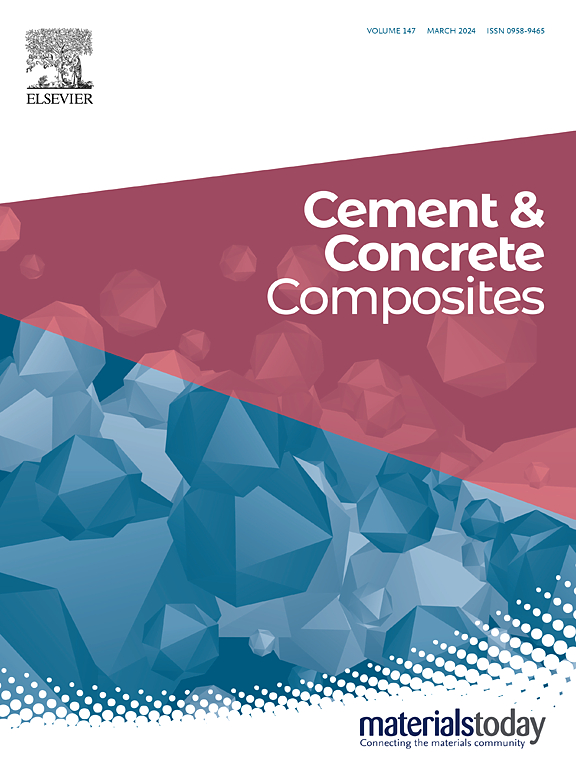海水对钙硅水合物(C-S-H)凝胶微观结构的影响
IF 13.1
1区 工程技术
Q1 CONSTRUCTION & BUILDING TECHNOLOGY
引用次数: 0
摘要
海水海砂混凝土已经成为一种很有前途的可持续建筑材料,利用丰富的海洋资源来减轻对淡水的依赖,解决全球沙子短缺问题,同时具有经济和生态优势。尽管具有潜力,但普通硅酸盐水泥(OPC)与补充胶凝材料(SCMs)在海水中的水化机制仍未得到解决,这阻碍了对其长期耐久性的预测。本文研究了海水对alite (C3S, OPC的主要熟料)-二氧化硅(SiO2, SCMs的主要成分)水化体系的影响,并将其作为OPC和SCMs的简化模型,重点研究了水化动力学、水化产物以及不同钙硅比(Ca/Si)下的C-S-H凝胶的微观结构演变。与海水和去离子水混合1天和28天的对比分析表明,海水显著加快了C3S-SiO2体系的水化速率,且由于二氧化硅的掺入,这一效应被放大,并持续整个水化过程。海水中的水化作用导致形成独特的产物,包括氯化钠和石膏,随着二氧化硅含量的增加,它们的数量也会增加。此外,海水暴露改变了C-S-H凝胶的微观结构,使其总量增加。然而,较高的二氧化硅含量(较低的Ca/Si比)促进了钠离子和氯离子的吸附,从而降低了C-S-H的平均分子链长和聚合度。与去离子水体系相比,高硅含量也降低了微力学性能,表现为海水体系中C-S-H密度向低偏移,平均模量下降幅度更大。本文章由计算机程序翻译,如有差异,请以英文原文为准。
Influence of seawater on the microstructure of calcium-silicate-hydrate (C-S-H) gels with varying Ca/Si ratios based on alite-silicon dioxide system
Seawater sea-sand concrete has emerged as a promising sustainable construction material, leveraging abundant marine resources to mitigate freshwater dependency and address global sand scarcity while offering economic and ecological advantages. Despite its potential, the hydration mechanisms governing ordinary Portland cement (OPC) blended with supplementary cementitious materials (SCMs) in seawater remain unresolved, impeding predictions of long-term durability. This study investigated the influence of seawater on the alite (C3S, the primary clinker in OPC)-silicon dioxide (SiO2, the main composition of SCMs) hydration system, employed as a simplified model for OPC and SCMs, with a particular emphasis on hydration kinetics, hydration products, and the microstructural evolution of calcium-silicate-hydrate (C-S-H) gels with varying calcium-to-silicon (Ca/Si) ratios. Comparative analyses of specimens mixed with seawater or deionized water for 1 and 28 days revealed that seawater significantly accelerated the hydration rate of C3S-SiO2 system, an effect amplified by the incorporation of silica and sustained throughout hydration. Hydration in seawater led to the formation of unique products, including sodium chloride and gypsum, with increased silica content enhancing their amounts. Furthermore, seawater exposure altered the C-S-H gel microstructure, enhancing the overall amount. However, higher silica contents (lower Ca/Si ratios) promoted an increased adsorption of sodium and chloride ions, and consequently decreased the mean molecular chain length and polymerization degree of C-S-H. The high silica content also degraded the micromechanical properties, which was reflected by the shifts towards lower-density C-S-H and a greater decrease in average modulus in the seawater system compared to the deionized water system.
求助全文
通过发布文献求助,成功后即可免费获取论文全文。
去求助
来源期刊

Cement & concrete composites
工程技术-材料科学:复合
CiteScore
18.70
自引率
11.40%
发文量
459
审稿时长
65 days
期刊介绍:
Cement & concrete composites focuses on advancements in cement-concrete composite technology and the production, use, and performance of cement-based construction materials. It covers a wide range of materials, including fiber-reinforced composites, polymer composites, ferrocement, and those incorporating special aggregates or waste materials. Major themes include microstructure, material properties, testing, durability, mechanics, modeling, design, fabrication, and practical applications. The journal welcomes papers on structural behavior, field studies, repair and maintenance, serviceability, and sustainability. It aims to enhance understanding, provide a platform for unconventional materials, promote low-cost energy-saving materials, and bridge the gap between materials science, engineering, and construction. Special issues on emerging topics are also published to encourage collaboration between materials scientists, engineers, designers, and fabricators.
 求助内容:
求助内容: 应助结果提醒方式:
应助结果提醒方式:


